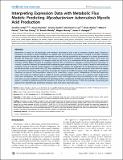Interpreting expression data with metabolic flux models: predicting Mycobacterium tuberculosis mycolic acid production
Author(s)
Murray, Megan B.; Moody, D. Branch; Cheng, Tan-Yun; Farhat, Maha R.; Galagan, James E.; Weiner, Brian; Lun, Desmond S.; Brandes, Aaron; Colijn, Caroline; Zucker, Jeremy; ... Show more Show less
DownloadColijn-2009-Interpreting express.pdf (1.156Mb)
PUBLISHER_CC
Publisher with Creative Commons License
Creative Commons Attribution
Terms of use
Metadata
Show full item recordAbstract
Metabolism is central to cell physiology, and metabolic disturbances play a role in numerous disease states. Despite its importance, the ability to study metabolism at a global scale using genomic technologies is limited. In principle, complete genome sequences describe the range of metabolic reactions that are possible for an organism, but cannot quantitatively describe the behaviour of these reactions. We present a novel method for modeling metabolic states using whole cell measurements of gene expression. Our method, which we call E-Flux (as a combination of flux and expression), extends the technique of Flux Balance Analysis by modeling maximum flux constraints as a function of measured gene expression. In contrast to previous methods for metabolically interpreting gene expression data, E-Flux utilizes a model of the underlying metabolic network to directly predict changes in metabolic flux capacity. We applied E-Flux to Mycobacterium tuberculosis, the bacterium that causes tuberculosis (TB). Key components of mycobacterial cell walls are mycolic acids which are targets for several first-line TB drugs. We used E-Flux to predict the impact of 75 different drugs, drug combinations, and nutrient conditions on mycolic acid biosynthesis capacity in M. tuberculosis, using a public compendium of over 400 expression arrays. We tested our method using a model of mycolic acid biosynthesis as well as on a genome-scale model of M. tuberculosis metabolism. Our method correctly predicts seven of the eight known fatty acid inhibitors in this compendium and makes accurate predictions regarding the specificity of these compounds for fatty acid biosynthesis. Our method also predicts a number of additional potential modulators of TB mycolic acid biosynthesis. E-Flux thus provides a promising new approach for algorithmically predicting metabolic state from gene expression data.
Date issued
2009-08Department
Massachusetts Institute of Technology. Department of BiologyJournal
PLoS Computational Biology
Publisher
Public Library of Science
Citation
Colijn, Caroline et al. “Interpreting Expression Data with Metabolic Flux Models: Predicting Mycobacterium tuberculosis Mycolic Acid Production.” PLoS Comput Biol 5.8 (2009): e1000489.
Version: Final published version
ISSN
1553-734X
1553-7358